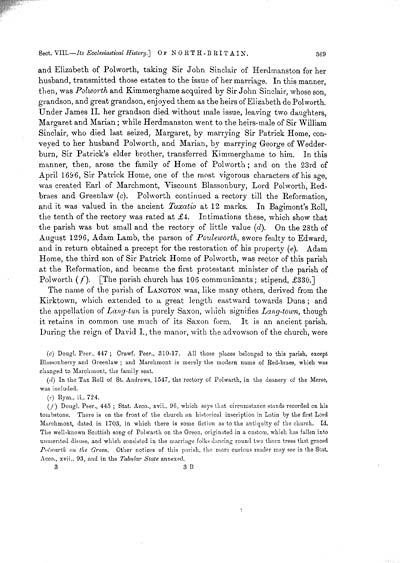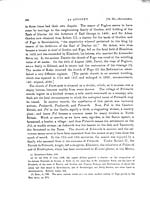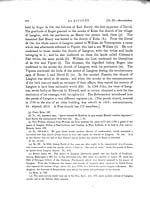Volume 3
(381) Page 369
Download files
Individual page:
Thumbnail gallery: Grid view | List view

369 and Elizabeth of Polworth, taking Sir John Sinclair of Herdmanston for her husband, transmitted those estates to the issue of her marriage. In this manner, then, was Polworth and Kimmerghame acquired by Sir John Sinclair, whose son, grandson, and great grandson, enjoyed them as the heirs of Elizabeth de Polworth. Under James II. her grandson died without male issue, leaving two daughters, Margaret and Marian; while Herdmanston went to the heirs-male of Sir William Sinclair, who died last seized, Margaret, by marrying Sir Patrick Home, con- veyed to her husband Polworth, and Marian, by marrying George of Wedder- burn, Sir Patrick's elder brother, transferred Kimmerghame to him. In this manner, then, arose the family of Home of Polworth; and on the 23rd of April 1696, Sir Patrick Home, one of the most vigorous characters of his age, was created Earl of Marchmont, Viscount Blassonbury, Lord Polworth, Bed- braes and Greenlaw (c). Polworth continued a rectory till the Reformation, and it was valued in the ancient Taxatio at 12 marks. In Bagimont's Roll, the tenth of the rectory was rated at �4. Intimations these, which show that the parish was but small and the rectory of little value (d). On the 28th of August 1296, Adam Lamb, the parson of Pouleworth, swore fealty to Edward, and in return obtained a precept for the restoration of his property (e). Adam Home, the third son of Sir Patrick Home of Polworth, was rector of this parish at the Reformation, and became the first protestant minister of the parish of Polworth (f). [The parish church has 106 communicants; stipend, �330.] The name of the parish of LANGTON was, like many others, derived from the Kirktown, which extended to a great length eastward towards Duns ; and the appellation of Lang-tun is purely Saxon, which signifies Lang-town, though it retains in common use much of its Saxon form. It is an ancient parish. During the reign of David I., the manor, with the advowson of the church, were (c) Dougl. Peer., 447 ; Crawf. Peer., 310-17. All those places belonged to this parish, except Blassonberry and Greenlaw ; and Marchmont is merely the modern name of Bed-braes, which was changed to Marchmont, the family seat. (d) In the Tax Roll of St. Andrews, 1547, the rectory of Polwarth, in the deanery of the Merse, was included. (e) Rym., ii., 724. (f) Dougl. Peer., 445 ; Stat. Acco., xvii., 96, which says that circumstance stands recorded on his tombstone. There is on the front of the church an historical inscription in Latin by the first Lord Marchmont, dated in 1703, in which there is some fiction as to the antiquity of the church. Id. The well-known Scottish song of Polwarth on the Green, originated in a custom, which has fallen into unmerited disuse, and which consisted in the marriage folks dancing round two thorn trees that graced Polwarth on the Green. Other notices of this parish, the more curious reader may see in the Stat. Acco., xvii., 93, and in the Tabular State annexed. 3 3 B
Set display mode to:
![]() Universal Viewer |
Universal Viewer | ![]() Mirador |
Large image | Transcription
Mirador |
Large image | Transcription
Images and transcriptions on this page, including medium image downloads, may be used under the Creative Commons Attribution 4.0 International Licence unless otherwise stated. ![]()
| Caledonia, or, An account, historical and topographic of North Britain from the most ancient to the present times > Volume 3 > (381) Page 369 |
|---|
| Permanent URL | https://digital.nls.uk/74528836 |
|---|---|
| Description | Vol. III. |
|---|---|
| Attribution and copyright: |
|

